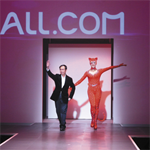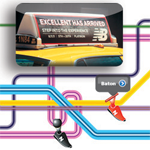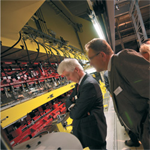| virtual/hybrid Event |
Company:
Cisco Systems Inc.
Event: Cisco Academy Conference 2012
Objectives: Increase the number of Networking Academy instructors participating in training.
Strategy: Host a hybrid event with live and virtual components to expand the event's reach beyond the venue.
Tactic: Enhance the virtual component of the event to add value for virtual attendees. Integrate live and virtual events to facilitate collaboration and increase attendee comfort with social-media technology.
Results: Grew attendance by 38 percent and increased Twitter following by 75 percent. In surveys, 96 percent of loyalists and 84 percent of first timers reported having their objectives met.
Creative Agency: Cisco Systems Inc.,
www.cisco.com
Production Agencies:
Cvent Inc.,
Budget: $285,000
|
 |

n the span of 60 seconds, 168 million emails are sent, 98,000 tweets are tweeted, and 698,000 Web searches are conducted. And for most of us, the invisible lines of that communication are something akin to magic — we don't understand where it comes from or how it works; we only care that it does. But for every bit of data we launch into cyberspace, there is an information-technology (IT) professional who made that magic happen, someone who understands the difference between megabits, megabytes, and megahertz; speaks fluent computer; and is a phone call away lest the magic stop working.
Technology is proliferating and evolving at an incalculable speed, and the race is on to educate enough IT professionals to manage the continuous explosion of connectivity. In tandem with preparing our global IT workforce, technology instructors around the world have the daunting task of keeping pace with the technological advancements announced nearly every day. Yet even they can be bowled over by the technology tidal wave, so someone must tackle the task of teaching the teachers.
A Conscientious Giant
Cisco Systems Inc. reins as a giant of nearly incomprehensible proportions in the world of computer network technology. Its $46 billion annual revenue portfolio extends to every facet of digital connectivity, providing wireless, voice, storage, security, routing, and server solutions to billions of people around the globe.
This giant, however, has a soft side — a Corporate Social Responsibility policy that demands it try to improve the world it has so benefitted from. To that end, Cisco established the Cisco Networking Academy in 1997 to foster training in information and communication technology (ICT). The program consists of a classroom curriculum, online teaching materials, interactive tools, and hands-on learning lessons bundled into an education program that is available at no cost to nonprofit schools and organizations. The only price tag attached to using the academy curriculum is that institutions wanting to teach it must supply and pay for the teacher, with schools usually selecting someone already on its faculty to deliver the courses.
Today, the Cisco Networking Academy has 10,000 schools and organizations using the curriculum in 165 countries, collectively educating a million students a year. Using the free materials, high schools, community colleges, universities, and groups like Job Corps. deliver cutting-edge instruction for students seeking careers in the technology field.
In an arena where technology is nearly obsolete literally moments after it is invented, however, keeping the curriculum current on evolving topics in ICT is paramount to the success of the Cisco Networking Academy. But the curriculum is only as good as the instructors teaching it, Cisco Global Engagement Organization marketing manager Stephanie Kelly says, because if the teachers don't understand it, their students never will.
Instructors are provided access to teaching aids via regional training events and Web portals. But the greatest opportunity for professional development is at an annual Academy Conference, an event that has evolved as much as the technology.
For most of the lifespan of the Academy Conference, it bounced around to schools and hotel ballrooms across the country. Organizers hoped that if they found the sweet spot of the right venue in the right geographic location, attendance would blossom. But despite years of trial and error, the number of attendees remained stagnant in the low 600s. That figure represented just 12 percent of the instructor army delivering Networking Academy courses around the world, and organizers went back to the drawing board to bolster attendance.
Attendee fees were nominal, but because teachers are not employed by Cisco, the company found itself with little leverage in terms of urging participation. While instructors craved the professional development, many worked for institutions that lacked the budgets to send them to such conferences. If it wanted teachers to get the training, Cisco was going to have to reinvent its academy concept.
So in 2010 and 2011, Cisco brought the event to instructors by adding a virtual component to the conference. It made session material and limited live broadcasts available, and moved the needle forward each year on attendance through virtual participation. But organizers wanted to improve the program's quality in the virtual realm to make it as immersive as the live event, and they knew the outcomes for all would be stronger if they could get attendees in both the live and virtual events cohered into one collaborative community.
And then came word of budget shifts to department spending within Cisco, and Kelly's team was told it would have to work its academy magic with a 26-percent smaller budget. Doing the same with less is challenge enough, but to achieve their growth goal, academy organizers would have to do more with less, and they sat down once again to reimagine the event.
There's No Place Like Home
To establish a new strategy, the team dissected past events to understand who was attending and why. It found that historically 37 percent of attendees were first timers seeking to improve their classroom skills, and 42 percent were "loyalists" who had attended more than four conferences and cited education as the driving factor in their decision to attend. The other 21 percent had participated a couple of times and reported putting a high emphasis on the location and fun factor of the conference.
Organizers decided Cisco's mission was best served by sustaining loyalists and converting first timers to loyalist status, believing those two groups represented not only the lion's share of attendees, but also the core purpose for holding the Academy Conference. The more first timers who could be converted to loyalists, the better the educational foundation in Networking Academy classrooms.
According to attendee analytics, the virtual component had produced more than double the percentage of first timers as the live event and with good reason: Participation in the virtual event was free. "Enhancing the virtual event presented a great opportunity to grow the overall attendance," Kelly says, "but we needed to improve the virtual experience in order to turn those attendees into loyalists."
The first order of business was to determine where the 2012 event should be held. Planners decided to bring it to the Cisco headquarters in San Jose, CA, a facility with an entire floor devoted to meeting space and access to hands-on learning. Moreover, bringing the conference in-house would reduce costs.
Socializing the Masses
With the event site determined, the team designed the live academy for 2012 and its virtual counterpart on parallel tracks, at each turn looking for ways to stitch them together to create one comprehensive learning event. Key to that end was leveraging technology, but for a conference of IT instructors, Cisco had a surprising problem. "Believe it or not, instructors who teach technology are not necessarily the first to adopt new tech tools or things like social media," Kelly says. Past efforts to integrate Facebook, chat rooms, and blogs had been met with a lukewarm response, but there was one tool instructors could get their arms around: Twitter.
"So rather than trying to boil the ocean with our resources, we focused on what we knew was working with social media and put our energy into improving it," Kelly says.
In the weeks before Academy Conference 2012, Cisco began sending tweets to amp up excitement for the event. They promoted hashtags that would be used during the event and gave away pre-event prizes, all the while working to actively engage instructors in conversations about Academy Conference.
In person, event offerings included a redesigned agenda to better aid attendees in navigating the 153 hours of sessions. The schedule, as well as handouts, session descriptions, and more, was available digitally by downloading an app that connected in-person attendees to the same virtual space that those attending the event remotely were using.
During the three-day conference, organizers scheduled a series of peer-to-peer roundtable discussions to help attendees connect with and learn from each other. In addition, Cisco strategically distributed its technology experts to lunch tables around the room to facilitate conversations and answer questions.
The event also featured tours through Cisco labs and presentations by high-level Cisco speakers. Organizers hoped the immersion into Cisco culture would become the tie that bound first timers into becoming devoted attendees. Due to the space constraints of the Cisco facility, in-person attendance was capped at 400, a registration figure that was quickly reached. But in the virtual arena, the company had no limits, so it promoted the event right up to the days before it opened.
For virtual attendees, the Academy Conference promised more live broadcasting from sessions, allowing them to experience much of the same content people at the live event received. Anything not simulcast was made available via webinars and virtual handouts, and the portal through which they accessed the info contained a splash page with a welcome video from their regional Cisco contact and an invitation to ask any questions that might arise. And though they couldn't sit at roundtables or have lunch in San Jose, virtual attendees participated in a vibrant online community that included roundtable discussions, chat areas, and blogs.
Game Gigs
Though in-person attendees hadn't really availed themselves of many of the event's virtual components in the past, organizers wanted to coax reluctant instructors to embrace technology more fully, and to integrate the live event with its virtual counterpart. As such, they put greater emphasis on structuring virtual elements to make them user friendly, useful, and necessary for things like handouts or the event schedule. And to cover their bases in making the virtual tool attractive, Cisco created a game that could only be played and tracked through online resources.
One part of the game contained trivia questions that attendees could answer by attending sessions or looking up virtual documents. Each correct answer earned points, which were displayed next to an attendee's virtual profile. At the end of the event, those with the highest scores received prizes such as Kindles and e-books.

To immerse instructors deeper into the online resources, organizers incentivized virtual actions, offering achievement badges and points for activities instructors completed. "We wanted more attendees to blog and share best practices because learning from each other is something attendees find very useful, so we introduced a badge they could earn by blogging," Kelly says. Other achievement badges included Session Seeker (earned by attending online sessions), Avid Reader (earned by saving documents to a virtual briefcase), Trivia Star (earned by scoring 21,000 points or higher on the trivia game), Cisco Connector (earned by visiting the virtual event meeting rooms), and Chatter (earned by initiating and participating in online chats).
To nudge the competitive spirit along and facilitate a little good-natured ribbing, a leader board on the Web portal displayed point totals, and monitors set up throughout the Cisco facility displayed any tweets flying through the cybersphere. And for attendees, it was game on.
But Cisco integrated one more component into the contest: In order for points to be eligible for prizes, an attendee had to also complete a survey at the end of the event. The survey was brief, Kelly says, but went directly to the heart of the attendee experience with questions like, "Did Academy Conference meet your professional development objectives?" and, the one deemed most critical, "Would you recommend Academy Conference to your peers?"
Speaking Their Language
An unprecedented 96 percent of event loyalists said the conference had met their objectives, and 84 percent of first timers indicated they would participate again. Corporate Event Awards judges were not
surprised. "The way they focused on and really examined the target market made the difference in the end," one judge said.

On the virtual front, Academy Conference received similar praise. The satisfaction score of those using the online component rose from an average of 4.7 in 2011 to 4.85 out of 5 in 2012. Live session views also saw a dramatic 200-percent increase, documents downloaded to briefcases multiplied by a jaw-dropping 195 percent, and virtual meeting room visits increased 137 percent over the previous year.
In addition, Cisco's mission to coax instructors into a comfort zone with social media and other communication technologies was realized, as the conference netted a 75-percent increase in Twitter followers, a 108-percent increase in blogs posted by attendees, and a whopping 519-percent increase in the number of virtual chats initiated for one-on-one interaction.
Overall, registration for the event increased 38 percent, with 2,200 of those attendees (85 percent) participating virtually. But even with the growth of the event and the overwhelming attendee satisfaction, Cisco managed to cut the program's cost by 9 percent per person compared to the previous year.
What's more, the instructors weren't the only ones learning in San Jose. By studying its audience and persevering in its mission to do much more with less, Cisco picked up a few new tools of its own along the way and proved that if teachers are only as good as the instructor who taught them, then the technology industry is in pretty good shape. 




 n the span of 60 seconds, 168 million emails are sent, 98,000 tweets are tweeted, and 698,000 Web searches are conducted. And for most of us, the invisible lines of that communication are something akin to magic — we don't understand where it comes from or how it works; we only care that it does. But for every bit of data we launch into cyberspace, there is an information-technology (IT) professional who made that magic happen, someone who understands the difference between megabits, megabytes, and megahertz; speaks fluent computer; and is a phone call away lest the magic stop working.
n the span of 60 seconds, 168 million emails are sent, 98,000 tweets are tweeted, and 698,000 Web searches are conducted. And for most of us, the invisible lines of that communication are something akin to magic — we don't understand where it comes from or how it works; we only care that it does. But for every bit of data we launch into cyberspace, there is an information-technology (IT) professional who made that magic happen, someone who understands the difference between megabits, megabytes, and megahertz; speaks fluent computer; and is a phone call away lest the magic stop working.











